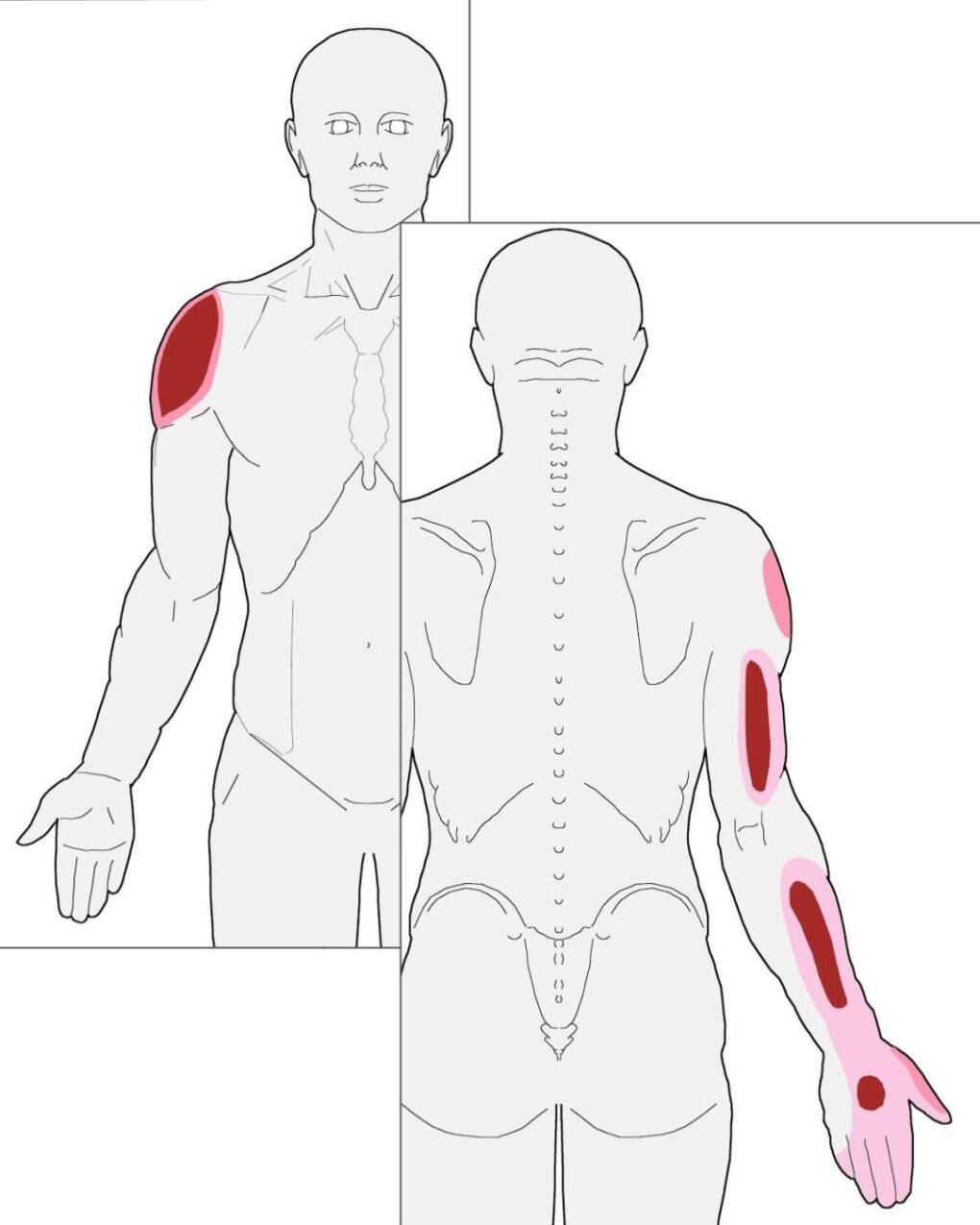Pain when pitching or reaching behind your body
Table of Contents
- How People Describe This Pain Pattern
- How You Activate and Intensify This Pain Pattern
- Self-Care – Getting Relief on Your Own
- Musculoskeletal Anatomy Behind Your Pain
- Therapy Notes for Massage and Bodywork
Want to skip ahead?
Here’s a link to my post about
getting relief on your own.
How People Describe This Pain Pattern


People complain of pain in the front of the shoulder, back of the upper arm, forearm, and hand. The primary complaint is often in the shoulder, especially when reaching behind the back to fasten a bra, tuck in a belt, etc.
The other common complaint is focused on forearm pain. Patients usually complain about the shoulder or other areas when asked if anything else in that arm bothers them.
Some patients complain of the whole pattern in the front of the shoulder and down the back of the arm. There has often been a history of this pain that has become chronic or a recent accident in those cases.
Same Motion, Different Muscle
Reaching behind the back is the test for both this muscle and infraspinatus. Both restrict reaching across the low back but with different pain patterns.
How You Activate and Intensify This Pain Pattern
This trigger point can be debilitating for pitchers. It creates intolerable pain in the shoulder that feels injurious and radiates down the arm. The subscapularis is also debilitating for pitchers but produces a different pain pattern and hurts earlier in the stretch.
Carrying objects creates pain with your arms extended in front of you. When you are extending your arm back, it doubles the stress by stretching the muscle at the same time. A typical example is reaching into the car’s back seat to get a bag or tend to a child. A yanking dog can create sudden pain, which is particularly worrisome when the referral extends into the hand.
Reaching Behind Your Head
Additionally, this pattern can become active and hurt when people strongly contract coracobrachialis. For example, this scenario happens when they reach back behind their heads for the seatbelt or headrest in the car. Also, this hurts when trying to roll hair in the back.
The Musculoskeletal Anatomy Behind Your Pain
Musculoskeletal Anatomy
The coracobrachialis, though a simple muscle, is often overlooked. However, it has statistically significant anomalies. Read more in this post about coracobrachalis anatomy.
Getting Relief on Your Own
Clinically Proven
Self-Care Strategies
Self-Care Posts have common sections to make them easy to follow and understand:
- Activities to Avoid or Change
- Strategies for Quick Relief
- Stretches and Exercise for Longer-Lasting Relief
- Yoga Corner
Therapy Notes for Massage and Bodywork
Better Bodywork
Through Shared Expertise
Therapy Notes provide details for cranial, spinal, and local joint work. These notes also link to a traditional neuromuscular protocol.
By treating integrative components first, direct work on the muscle becomes less intense while providing longer-lasting relief.
Support Integrative Works to
stay independent
and produce great content.
You can subscribe to our community on Patreon. You will get links to free content and access to exclusive content not seen on this site. In addition, we will be posting anatomy illustrations, treatment notes, and sections from our manuals not found on this site. Thank you so much for being so supportive.
Cranio Cradle Cup
This mug has classic, colorful illustrations of the craniosacral system and vault hold #3. It makes a great gift and conversation piece.
Tony Preston has a practice in Atlanta, Georgia, where he sees clients. He has written materials and instructed classes since the mid-90s. This includes anatomy, trigger points, cranial, and neuromuscular.
Question? Comment? Typo?
integrativeworks@gmail.com
Follow us on Instagram
*This site is undergoing significant changes. We are reformatting and expanding the posts to make them easier to read. The result will also be more accessible and include more patterns with better self-care. Meanwhile, there may be formatting, content presentation, and readability inconsistencies. Until we get older posts updated, please excuse our mess.